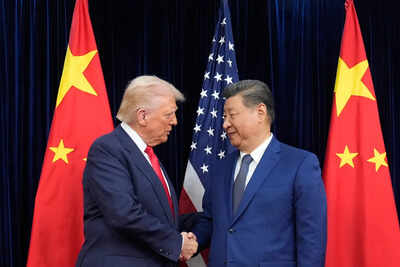US–China trade reset: From port fees, tariffs to rare earths — What Donald Trump and Xi Jinping agreed on

The trade talks between US President Donald Trump and Chinese President Xi Jinping in Busan last week resulted in several breakthrough agreements, easing tensions for the two economies. These ranged from soybean purchases, tariff cuts and rare-earth export restrictions and more, though details were initially withheld.
The White House on Saturday unveiled the complete terms of the deal, confirming that both sides have agreed to a temporary pause in their prolonged trade dispute.The agreement freezes new tariffs and export curbs, reinstates major agricultural purchases, and creates a one-year negotiation window. The White House said it also blocks a planned 100% tariff on Chinese goods, while China will pause its latest restrictions on rare earth minerals and magnets used in key industries.Here are what the two nations have agreed to:US agrees to cut tariffs tied to fentanyl-related productsA key provision is a reduction in US tariffs on Chinese imports linked to supplies of precursor chemicals used to make fentanyl. The tariff rate on those products, imposed earlier this year at 20%, will be lowered to 10%. Officials said this will bring the overall US tariff rate on Chinese imports down to roughly 47%, from the current 57%, once Trump’s earlier duties and a 10% “reciprocal” tariff introduced in April are accounted for, Reuters reported.China pauses rare-earth restrictions and lifts retaliationBeijing has agreed to suspend for one year the new export controls announced this month, which would have required licences for the export of rare earths and magnets, even when present only in trace amounts. The White House described this as “the de facto removal of controls China imposed in April 2025 and October 2022.” China will issue general licences covering rare earths, gallium, germanium, antimony and graphite for US users and their supply chains.US pauses expanded tech export blacklistWashington has agreed to freeze plans for a one-year expansion of its commerce department entity list, which would have prohibited US companies from selling technology, including semiconductor manufacturing equipment, to any firm more than 50% owned by an already-restricted entity. The measure would have added thousands of additional Chinese companies to the blacklist.Beijing removes retaliatory tariffsChina will also suspend all retaliatory tariffs introduced since 4 March, covering a wide range of American products including chicken, wheat, corn, cotton, sorghum, soybeans, pork, beef, aquatic products, fruits, vegetables and dairy. In addition, it will withdraw non-tariff countermeasures taken over the same period, such as putting US companies on “end user” and “unreliable entity” lists, Reuters reported.Soybean purchases resumeChina has committed to buying at least 12 million metric tonnes of US soybeans during the final two months of 2025, and at least 25 million metric tonnes per year for the following three years. Purchases of US sorghum and hardwood logs will also resume. The White House acknowledged that China had “largely stopped buying US soybeans this autumn,” after turning to Brazil and Argentina instead.China to lift trade barriers China will extend its market-based tariff exclusion process on US imports until 31 December 2026 and will terminate antitrust, anti-monopoly and anti-dumping investigations targeting American firms in the semiconductor supply chain. Beijing will also restart trade operations from Nexperia’s China facilities, allowing legacy chip production to reach global markets.Port fees and shipping disputeChina will remove retaliatory measures linked to the US Section 301 investigation into China’s control over global shipbuilding and logistics. The US, in turn, will pause for one year the new port fees that took effect on October 14, which applied to Chinese-built, -owned and -flagged vessels and were designed to boost US shipbuilding, as per a Reuters report. The White House said these fees, coupled with newly imposed 100% tariffs on Chinese-made ship-to-shore cranes, had already disrupted cargo movements and driven up shipping costs.Negotiations on maritime issues will continue alongside talks with South Korea and Japan on reviving US shipbuilding.The new arrangement marks a fragile but significant de-escalation in the trade war between Washington and Beijing, at least for the next 12 months.






